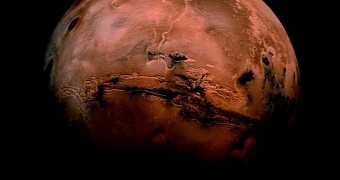Scientists have been studying the Red Planet for quite a while now. They've sent all sorts of robots and spacecraft to it and they've spent hours ogling over photos of the Martian surface or trying to better understand the makeup of this celestial body.
Still, there are plenty of questions that are yet to be answered. One of the Martian mysteries that science is yet to solve is whether or not the Red Planet's Grand Canyon was once home to massive glaciers.
According to researchers with the Bryn Mawr College in the US and the Freie Universitaet Berlin in Germany, mineralogical evidence at hand indicates that this was in fact the case. The scientists detail their work in a recent paper in the journal Geology.
The Martian Grand Canyon's secret past
First off, it must be said that Mars' Grand Canyon is officially named Valles Marineris. This geological formation is basically a rift system measuring over 4,000 kilometers (2,500 miles) in length and up to 200 kilometers (120 miles) in width.
What's more, scientists who have taken the time to study it say that this Martian rift system is as much as 7 kilometers (4 miles) deep in certain areas. This makes it one of the largest geological formations of this kind in the solar system.
Satellite images obtained over the years show that Mars' Grand Canyon displays certain features that researchers say are consistent with the markings one would expect flowing glaciers to leave on the surface of the Red Planet.
However, these features alone have failed to convince everybody that, at some point in its past, Mars' Valles Marineris was home to massive glaciers that, for reasons still unknown, disappeared without a trace long before we humans turned out attention to this distant planet.
The mineralogical evidence
The mineralogical evidence suggesting that this geological formations on Mars was once populated by glaciers boils down to a layer of mixed sulfate minerals that was documented towards the western end of the canyon system.
In their paper in the journal Geology, the Bryn Mawr College and Freie Universitaet Berlin scientists behind this research project argue that this layer most likely formed after atmospheric sulfur became trapped in ice, was warmed by the Sun, and reacted with water to birth highly acidic sulfate minerals.
“A joint team from Bryn Mawr College and the Freie Universitaet Berlin has identified what could be the first mineralogical evidence of past glaciers within the Valles Marineris: a layer of mixed sulfate minerals halfway up the three-mile-high cliffs of Ius Chasma at the western end of the canyon system.”
“They speculate that it may have formed via a mechanism similar to one observed at glaciers in the Svalbard on Earth: Atmospheric sulfur becomes trapped in the ice, is warmed by the sun, and reacts with the water to produce highly acidic sulfate minerals like jarosite along the margins of the glacier,” the Geological Society of America explains.
Truth be told, the discovery of this layer of mixed sulfate minerals is by no means ultimate proof that Mars' Grand Canyon was millennia ago populated by glaciers. Still, the find does add support to theories saying that this was in fact the case.

 14 DAY TRIAL //
14 DAY TRIAL //